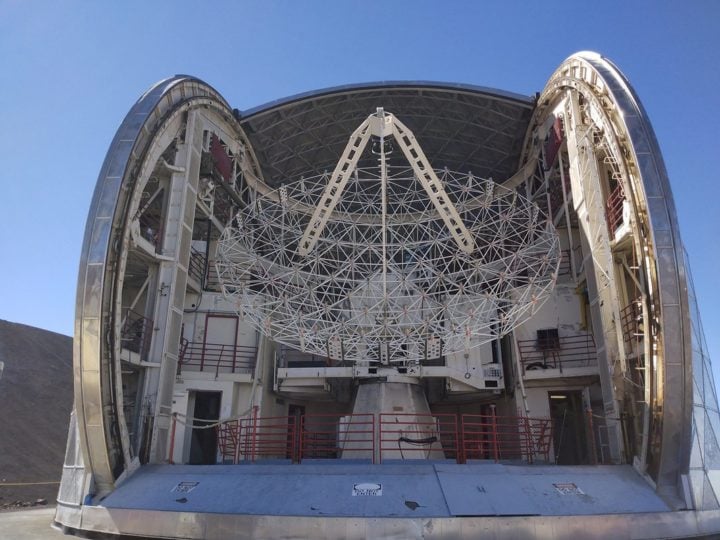Disassembly of the Caltech Submillimeter Observatory’s 34-foot diameter telescope on Maunakea has begun.
The current plan is to disassemble the telescope and its mirror into smaller parts and transport them down the mountain in standard shipping containers. The aluminum panels that make up the reflecting surface of the telescope were removed in July.

CSO observatory is pictured here after its primary mirror panels were removed. Image credit: Caltech
“Our team has started working inside the observatory to take apart the telescope and get it ready for removal,” Caltech physics professor and Caltech Submillimeter Telescope (CSO) Director Sunil Golwala said.
“We have also started to mobilize some of the large equipment needed to remove the telescope parts from the observatory up the mountain.”
Next month, Caltech expects to turn over the site to Goodfellow Bros., the general contractor that will remove the CSO buildings and carry out restoration of the site.
Work will pause during the winter due to inclement weather on the mountain, but restoration is expected to proceed in the summer of 2024 after all structures are removed.

CSO before the mirror panels were removed. Image credit: Caltech
The decommissioning of the observatory is being carried out according to the conservation district use permit issued by the state’s Department of Land and Natural Resources in January 2022. CSO is the first observatory to be removed under the 2010 Decommissioning Plan for Maunakea Observatories.
“In accordance with the permits guiding the decommissioning, cultural, construction, and archeological monitors will be present at all necessary phases,” Golwala says. A blessing was performed at the site to mark the decommissioning, with Caltech and CMS representatives in attendance.
The deconstruction and restoration of CSO is funded in part by the Gordon and Betty Moore Foundation. CSO’s 10.4-meter submillimeter telescope will be shipped to Chile, where it will continue its role as one of the world’s premier facilities for astronomical research and instrumentation development at submillimeter wavelengths, and where it will be renamed the Leighton Chajnantor Telescope.
Caltech’s contribution to the move is being funded by the Heising-Simons Foundation.
CSO came online in 1987 and was used by scientists at Caltech and other institutions, including almost 200 student and postdoctoral researchers, to open a new submillimeter window on the universe. A summary of CSO’s contributions to astronomy and astronomical instrumentation are available here.
Written by Whitney Clavin
Source: Caltech

